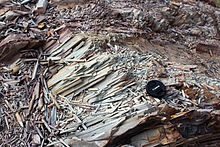Style slate
Griffelschiefer is a predominantly commercial - handcrafted name for an application-oriented variant of clay slate .
description
The parts of a gray-blue and very fine-grained clay slate suitable for pen slate can be split into regular prismatic pieces and, because of their workability, are made into slate pens when they are still moist . In this way, in pen form, you can use them to write on slates (from a suitable variety of slate called slate, and between which the pen slate forms layers). Typically, stylized slate has no recognizable layered structure and is often gray-blue in color. Its use for this purpose is historical.
In petrographic contexts, slate styling is the property when it can be split into two levels like stems.
Occurrence
The Silurian and Ordovician mountain parts of the Thuringian Slate Mountains provide the most suitable rock for processing. The main fractures can be found on the Brand and Langenberg near Hasenthal and on the Fellberg in the Steinacher Forest of the Meininger Oberland . In addition, the style slate (less suitable for processing) occurs on Bohlen near Saalfeld , Garnsdorf , Wittmannsgereuth and Eisenberg.
In Bavaria there was a mining site near Ebersdorf (today part of Ludwigsstadt ).
processing
The divisibility is the consequence of the rock stalk secretion (true by simultaneous occurrence of the so-called false and foliation -related), which is why this decomposes upon exposure to the air in long, prismatic stems.
The freshly broken stone must be kept moist until processing and is therefore stored in cellars. In the past, the rock was first split, then scraped with a scraper and sanded down. Later, however, a machine was used in which the stylus, after the prism edges had first been pounded with a scraper, were driven through a disc with holes two to four times, giving them a more perfect rounding and smoothness. A harder, iron-gray variety (coarse stone) that could only be split in one direction remained unused in the past, was then temporarily sawn (saw stone) and used as a cover stone on the razor stones and as a cover stone for the watchmakers .
literature
- Karl Bott (Hrsg.): Concise dictionary of the merchant. Lexicon for trade and industry . Vol. 5, Hanseatische Verlagsanstalt, Hamburg / Berlin 1927, p. 634
- Friedrich Müller : Bavaria's rich corner . Ackermann Verlag, Hof / Saale 1990, p. 80, ISBN 3-8112-0845-4

